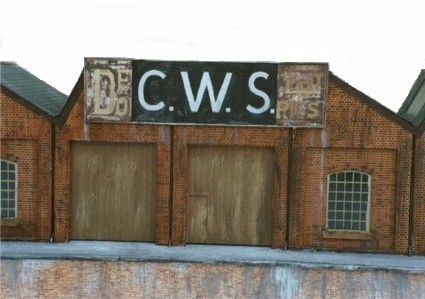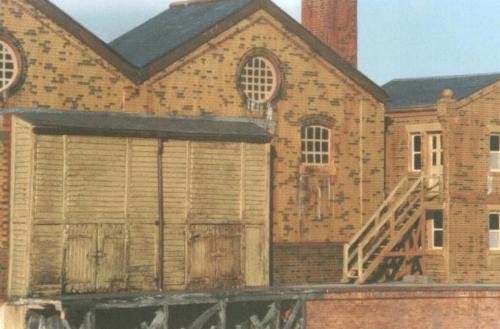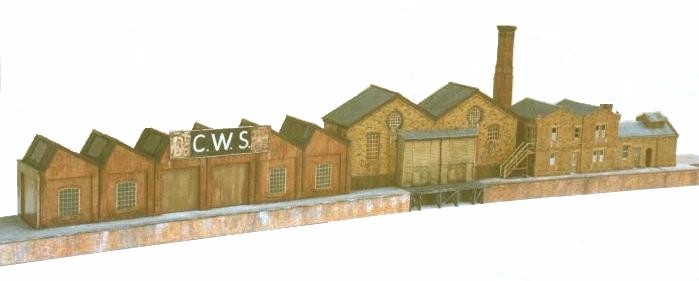Here we show a "low-relief" model of a
rail-served dairy.
indentA
"low-relief" model is one built with a front and the front part of the two
sides only, the back being plain. It is intended for fitting against a backscene where
there is not enough depth for a complete model but there remains a requirement to provide
a feature; in this case, a rail-served "industry" to increase the operating
potential of a model railway.
indentThe next two photographs show how by
placing sufficient detail on the front face of the model to distract the eye from the
shallowness of the roof, this can be an effective means of fitting a feature into a space
where there is not really room for it.
Close-up of the dairy loading bay
 |
indentNote how the
name-board has been created. The "Co-operative Wholesale Society"
was a creation of the 1930s and models of milk tankers branded CWS are available
commercially. The font and spacing of these letters was standard across the
newly-formed company and so only needed a part of the original nameboard. Some of
the lettering of the name of the previous owners of the dairy has however been
deliberately added to the space left over, although of course it has to be
well-weathered! (Close inspection reveals them to have been
called "Devon and Dorset |
Creameries Ltd".) Therefore with
a little imagination we can not only offer a model with visual interest at the front (to
distract the eye from the lack of depth), but add a sense of both period and an
approximate location while we're at it!
indentBy the careful introduction of this one detail we have
established both period and rough location of the model, as well as telling the viewer
what this factory produces! A simple enough idea really, given a little thought! |
Detail of the Boiler House.
 |
indentHere,
the addition of a wooden extension to the building suggests larger boilers have been
fitted inside the original building thereby giving yet more "history" and
substance to the model. The fact that this structure also provides an artistic
change from the brickwork is not coincidence - it is however, the result of
needing to find some means of filling the hole in the ends of the goods shed kit which I
used as a basis for the building! It may seem surprising that people obviously
capable of making a dairy from scratch should resort to the |
use of a kit. The reason is simple; time spent
on what is after all a background model can often be better spent on detailing the
foreground where one's efforts are both more easily seen and more effective.
Besides, the average 19th century factory building is so common-place that they all look
much the same and as such a model of one rarely receives a second glance.
indentThe use of a kit, or as in this case,
several (since the offices and the factory itself are both kits from the same range)
simply allow one to spend one's time on the more important details; such as the generous
quantities of pidgeon droppings which confirm this as a warm and welcoming building upon
which to perch, and the access stairs to the offices which help "bind" the whole
site together. One can just imagine the office junior nipping downstairs to get
some fresh "Gold Top" for the boss's morning cuppa ! |
indentIn passing we may
mention that COUNTRYSIDE MODELS do not
normally accept orders for single model buildings - on the other hand, if you ask for
something we'd find both unusual and enjoyable, you never know... (After all, we did
recently do a gasworks!)
